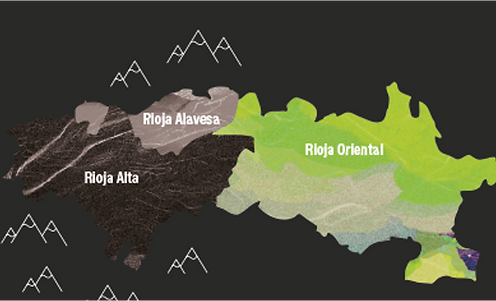
RIOJA ALAVESA-
the most prestigious wine region in Rioja


RIOJA
The D.O.Ca. Rioja is located in the north of Spain, on both sides of the Ebro River. Rioja is the oldest and most distinctive winegrowing region in Spain. With more than 65,000 hectares of vineyards, each town and terroir has its own personality, making Rioja a unique land.
Rioja’s climate benefits from a mix of Atlantic, Continental and Mediterranean climates. Hot summers and cold winters with somewhat high rainfall are all excellent for producing top quality grapes which go into producing exceptional Rioja wines. The annual rainfall is around 500 mm (20 inches) on the average, which forces the roots to burrow deep into the soil in search of water.
RIOJA'S 3 LARGE SUBREGIONS:
-
Rioja Alavesa
-
Rioja Alta
-
Rioja Oriental

RIOJA'S 3 MAIN
SOIL TYPES:
•CHALKY CLAY: 25% (Rioja Alavesa, parts of Rioja Alta)
•FERROUS CLAY: 25% (found throughout Rioja)
•ALLUVIAL: 50% (found throughout Rioja)
RIOJA'S 14 GRAPE VARIETIES:
There are only 14 grape varieties allowed by the D.O.Ca. Rioja:
-
the 5 red grape varieties are Tempranillo, Garnacha, Graciano,
Mazuelo and Maturana.
-
the 9 white grape varieties are Viura, Malvasia, Garnacha Blanca,
Tempranillo Blanco, Maturana Blanca, Turruntés, Chardonnay,
Sauvignon Blanc and Verdejo.
.jpeg)

RIOJA ALAVESA
Rioja Alavesa is the smallest (extending just over 300 km) and northernmost of the three wine-producing sub-regions in Rioja, Spain, bordering Rioja Alta to the southwest and Rioja Baja to the southeast. It is situated to the north of the Ebro River, straddling La Rioja and the Alava province within the autonomous community of the País Vasco (Basque Country). Rioja Alavesa is the closest of the three sub-regions to the Atlantic Ocean and thus the one most influenced by its cooling effects. Although its climate is predominately Atlantic, it is dry and sunny. This wine region is well known for having the perfect combination of soils and climate, both of which influence the flavors and textures of the wines we make, has become arguably the most prestigious wine region in Rioja.

RIOJA ALAVESA'S THREE VERY SPECIAL GEOGRAPHICAL FEATURES
The 3 geographical features below determine the quality of the wines produced in Rioja Alavesa since all of these factors contribute to producing fuller body wines with good acidity and very fragrant aromas in their youth.
Sierra Cantabria Mountain Range: the ash-colored Cantabrian mountains dominate the landscape here, towering over the region to the north. This Sierra Cantabria mountain range shelters the vineyards from the cold, clouds and rainy winds coming from the North and the Cantabric Sea. These conditions help the vines and grapes have the longest growing season throughout all of Europe. The grapes start to ripen in early June and the harvest usually takes place around mid-October. This long growing season gives the tannins enough time to melt and give way for very soft, subtle and elegant wines.
-
High Altitude: the vineyards in Rioja Alavesa are structured in the form of terraces, divided into small plots and lie at high altitudes (400–1200m/1300–3930ft), resulting in cooler temperatures that help the grapes acquire and retain moderate acid levels and good color.
-
Soil: the soil on the slopes and terraces where most of the vines are grown is rich in chalky clay and limestone. This type of soil, calcareous clay, is rich in limestone, permeable to water and difficult to machine harvest. Vineyards in this area have a low vine density with large spacing between rows. This is due to the relatively poor conditions of the soil with the vines needing more distance from each other and less competition for the nutrients in the surrounding soil. These soils produce stable wines with high glycemic content, high pH, good color, greater aging ability and rich in extract.






